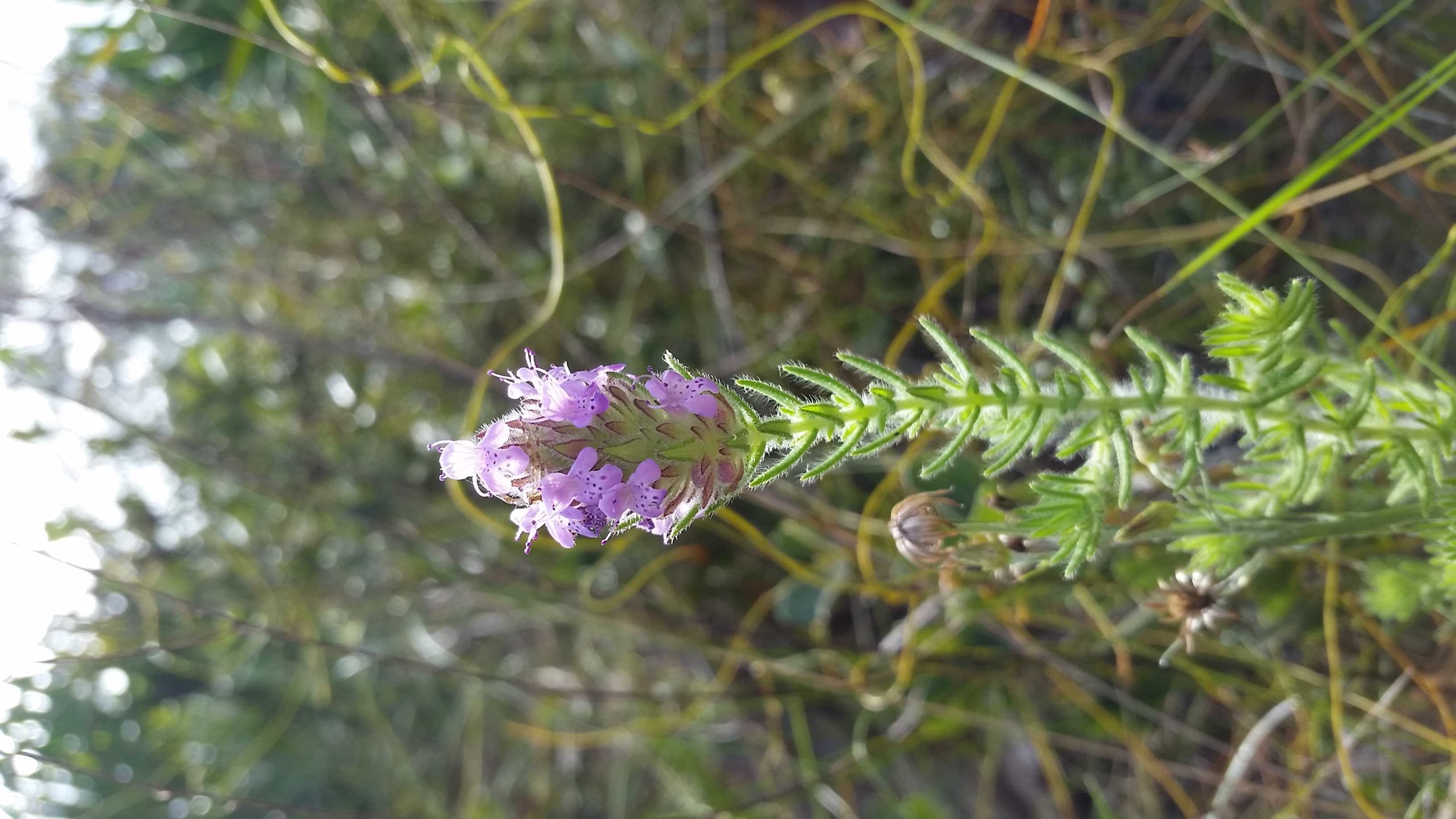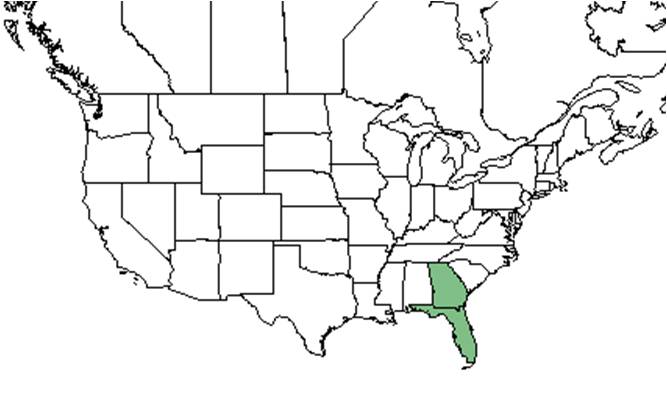Difference between revisions of "Piloblephis rigida"
(→Conservation and Management) |
HaleighJoM (talk | contribs) (→Ecology) |
||
| (13 intermediate revisions by 6 users not shown) | |||
| Line 18: | Line 18: | ||
}} | }} | ||
| − | Common | + | Common names: Wild pennyroyal, Florida pennyroyal<ref name="weakley">Weakley, A.S. 2015. Flora of the southern and mid-atlantic states. Working Draft of 21 May 2015. University of North Carolina at Chapel Hill, Chapel Hill, North Carolina.</ref> |
==Taxonomic notes== | ==Taxonomic notes== | ||
| − | Synonyms: ''Pycnothymus rigidus'' (Bartram ex Bentham) Small; ''Satureja rigida'' Bartram ex Bentham | + | Synonyms: ''Pycnothymus rigidus'' (Bartram ex Bentham) Small; ''Satureja rigida'' Bartram ex Bentham.<ref name="weakley">Weakley, A.S. 2015. Flora of the southern and mid-atlantic states. Working Draft of 21 May 2015. University of North Carolina at Chapel Hill, Chapel Hill, North Carolina.</ref> |
| − | This is the only species in the genus ''Piloblephis''<ref name="florida">[[http://floridawildflowerfoundation.blogspot.com/2015/01/wild-pennyroyal.html]]Florida Wildflower Foundation. Accessed: February 20, 2016</ref> | + | Varieties: none.<ref name="weakley">Weakley, A.S. 2015. Flora of the southern and mid-atlantic states. Working Draft of 21 May 2015. University of North Carolina at Chapel Hill, Chapel Hill, North Carolina.</ref> |
| + | |||
| + | This is the only species in the genus ''Piloblephis.''<ref name="florida">[[http://floridawildflowerfoundation.blogspot.com/2015/01/wild-pennyroyal.html]]Florida Wildflower Foundation. Accessed: February 20, 2016</ref> In Greek, Pilo is hairy and belphis is eyelid, this refers to the hairs on the flower. The name rigida refers to the stiff branches.<ref name="eat">[[http://www.eattheweeds.com/florida-pennyroyal-piloblephis-rigida-2/]]Eat the Weeds. Accessed: February 20, 2016</ref> | ||
==Description== | ==Description== | ||
<!-- Basic life history facts such as annual/perrenial, monoecious/dioecious, root morphology, seed type, etc. --> | <!-- Basic life history facts such as annual/perrenial, monoecious/dioecious, root morphology, seed type, etc. --> | ||
| − | This is a short lived perennial species with thin woody stems and needle-like leaves that give off a pennyroyal smell when crushed<ref name="hawthorn">[[http://hawthornhillwildflowers.blogspot.com/2010/11/false-pennyroyal-piloblephis-rigida.html]] Native Florida Wildflowers. Accessed: February 20, 2016</ref> | + | This is a short lived perennial species with thin woody stems and needle-like leaves that give off a pennyroyal smell when crushed.<ref name="hawthorn">[[http://hawthornhillwildflowers.blogspot.com/2010/11/false-pennyroyal-piloblephis-rigida.html]] Native Florida Wildflowers. Accessed: February 20, 2016</ref> The 2-lipped flowers are purple with dark purple spots on the lower tips, arranged in dense, showy clusters.<ref name="florida"/> |
==Distribution== | ==Distribution== | ||
| − | + | ''Piloblephis rigida'' is endemic to the longleaf pine range<ref>Sorrie, B. A. and A. S. Weakley 2001. Coastal Plain valcular plant endemics: Phytogeographic patterns. Castanea 66: 50-82.</ref> from peninsular Florida, some counties in Georgia, and a few western Bahamas islands.<ref name="eat"/> | |
| + | |||
| + | The ''Piloblephis'' genera is endemic to the longleaf pine range from southeastern Virginia to central Florida and west to southeast Texas.<ref>Sorrie, B. A. and A. S. Weakley 2001. Coastal Plain valcular plant endemics: Phytogeographic patterns. Castanea 66: 50-82.</ref> | ||
==Ecology== | ==Ecology== | ||
===Habitat=== <!--Natural communities, human disturbed habitats, topography, hydrology, soils, light, fire regime requirements for removal of competition, etc.--> | ===Habitat=== <!--Natural communities, human disturbed habitats, topography, hydrology, soils, light, fire regime requirements for removal of competition, etc.--> | ||
| − | It can be found in well drained sunny locations, that include pine flatwoods, sandhills, and xeric oak/saw palmetto scrubs<ref name="hawthorn"/> | + | It can be found in well drained sunny locations, that include pine flatwoods, sandhills, and xeric oak/saw palmetto scrubs.<ref name="hawthorn"/><ref name="FSU Herbarium">Florida State University Robert K. Godfrey Herbarium database. URL: [http://herbarium.bio.fsu.edu http://herbarium.bio.fsu.edu]. Last accessed: October 2015. Collectors: Cecil R. Slaughter. States and Counties: Florida: Osceola. Compiled by Tall Timbers Research Station and Land Conservancy.</ref> Associated species include oaks and saw palmetto. |
===Phenology=== <!--Timing off flowering, fruiting, seed dispersal, and environmental triggers. Cite PanFlora website if appropriate: http://www.gilnelson.com/PanFlora/ --> | ===Phenology=== <!--Timing off flowering, fruiting, seed dispersal, and environmental triggers. Cite PanFlora website if appropriate: http://www.gilnelson.com/PanFlora/ --> | ||
| Line 42: | Line 46: | ||
<!--===Fire ecology===--> <!--Fire tolerance, fire dependence, adaptive fire responses--> | <!--===Fire ecology===--> <!--Fire tolerance, fire dependence, adaptive fire responses--> | ||
===Pollination=== | ===Pollination=== | ||
| − | + | ''Piloblephis rigida'' has been observed at the Archbold Biological Station to host sweat bees from the Halictidae family such as ''Agapostemon splendens, Augochlorella aurata, Lasioglossum miniatulus'' and ''L. nymphalis'', leafcutting bees from the Megachilidae family such as ''Megachile brevis pseudobrevis'', and thread-waisted wasps from the Sphecidae family such as ''Oxybelus laetus fulvipes''.<ref name="Deyrup 2015">Deyrup, M.A. and N.D. 2015. Database of observations of Hymenoptera visitations to flowers of plants on Archbold Biological Station, Florida, USA.</ref> | |
| − | + | <!--===Herbivory and toxicology===--> <!--Common herbivores, granivory, insect hosting, poisonous chemicals, allelopathy, etc--> | |
| − | Halictidae | ||
| − | |||
| − | Megachilidae | ||
| − | |||
| − | Sphecidae | ||
| − | <!--=== | ||
<!--===Diseases and parasites===--> | <!--===Diseases and parasites===--> | ||
| − | ==Conservation and | + | ==Conservation, cultivation, and restoration== |
| − | == | + | ==Cultural use== |
| − | The Miccosukee and Seminole Indians made tea and flavored soups and used it to repel insects <ref name="eat"/> | + | The Miccosukee and Seminole Indians made tea and flavored soups and used it to repel insects.<ref name="eat"/> |
==Photo Gallery== | ==Photo Gallery== | ||
| Line 62: | Line 60: | ||
==References and notes== | ==References and notes== | ||
| − | |||
| − | |||
| − | |||
Latest revision as of 08:45, 15 July 2022
| Piloblephis rigida | |
|---|---|

| |
| Photo taken by Michelle Smith at Jonathan Dickinson State Park | |
| Scientific classification | |
| Kingdom: | Plantae |
| Division: | Magnoliophyta - Flowering plants |
| Class: | Magnoliopsida – Dicotyledons |
| Order: | Lamiales |
| Family: | Lamiaceae ⁄ Labiatae |
| Genus: | Piloblephis |
| Species: | P. rigida |
| Binomial name | |
| Piloblephis rigida (W. Bartram ex Benth.) Raf. | |

| |
| Natural range of Piloblephis rigida from USDA NRCS Plants Database. | |
Common names: Wild pennyroyal, Florida pennyroyal[1]
Contents
Taxonomic notes
Synonyms: Pycnothymus rigidus (Bartram ex Bentham) Small; Satureja rigida Bartram ex Bentham.[1]
Varieties: none.[1]
This is the only species in the genus Piloblephis.[2] In Greek, Pilo is hairy and belphis is eyelid, this refers to the hairs on the flower. The name rigida refers to the stiff branches.[3]
Description
This is a short lived perennial species with thin woody stems and needle-like leaves that give off a pennyroyal smell when crushed.[4] The 2-lipped flowers are purple with dark purple spots on the lower tips, arranged in dense, showy clusters.[2]
Distribution
Piloblephis rigida is endemic to the longleaf pine range[5] from peninsular Florida, some counties in Georgia, and a few western Bahamas islands.[3]
The Piloblephis genera is endemic to the longleaf pine range from southeastern Virginia to central Florida and west to southeast Texas.[6]
Ecology
Habitat
It can be found in well drained sunny locations, that include pine flatwoods, sandhills, and xeric oak/saw palmetto scrubs.[4][7] Associated species include oaks and saw palmetto.
Phenology
Seen flowering late December 2015 at Jonathan Dickinson State Park on the Kitching Creek Trail by Michelle Smith; very abundant.
Pollination
Piloblephis rigida has been observed at the Archbold Biological Station to host sweat bees from the Halictidae family such as Agapostemon splendens, Augochlorella aurata, Lasioglossum miniatulus and L. nymphalis, leafcutting bees from the Megachilidae family such as Megachile brevis pseudobrevis, and thread-waisted wasps from the Sphecidae family such as Oxybelus laetus fulvipes.[8]
Conservation, cultivation, and restoration
Cultural use
The Miccosukee and Seminole Indians made tea and flavored soups and used it to repel insects.[3]
Photo Gallery
References and notes
- ↑ 1.0 1.1 1.2 Weakley, A.S. 2015. Flora of the southern and mid-atlantic states. Working Draft of 21 May 2015. University of North Carolina at Chapel Hill, Chapel Hill, North Carolina.
- ↑ 2.0 2.1 [[1]]Florida Wildflower Foundation. Accessed: February 20, 2016
- ↑ 3.0 3.1 3.2 [[2]]Eat the Weeds. Accessed: February 20, 2016
- ↑ 4.0 4.1 [[3]] Native Florida Wildflowers. Accessed: February 20, 2016
- ↑ Sorrie, B. A. and A. S. Weakley 2001. Coastal Plain valcular plant endemics: Phytogeographic patterns. Castanea 66: 50-82.
- ↑ Sorrie, B. A. and A. S. Weakley 2001. Coastal Plain valcular plant endemics: Phytogeographic patterns. Castanea 66: 50-82.
- ↑ Florida State University Robert K. Godfrey Herbarium database. URL: http://herbarium.bio.fsu.edu. Last accessed: October 2015. Collectors: Cecil R. Slaughter. States and Counties: Florida: Osceola. Compiled by Tall Timbers Research Station and Land Conservancy.
- ↑ Deyrup, M.A. and N.D. 2015. Database of observations of Hymenoptera visitations to flowers of plants on Archbold Biological Station, Florida, USA.